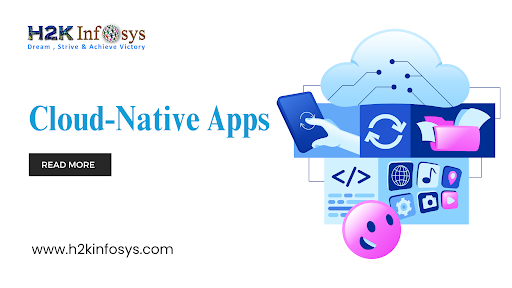Cloud Native Apps applications can be considered as collection of small independent and loosely coupled services. They are designed as to deliver well recognised business value like the ability to rapidly incorporate user feedback as for continuous improvement. Cloud native app development is a way of speed up how we build new applications, optimise existing ones and connect all. The main goal is to deliver apps to users want at the pace a business needs.
Suppose any app is cloud native this is specifically designed to provide a consistent development and automated management experience across private, public and hybrid clouds. Organisations use cloud computing to maximise the scalability and availability of apps. These benefits will be achieved through self service and on-demand of resources as automating the application life cycle from the development to production.
Cloud native development is an approach to building and updating the app when we improve quality and also reduce the risk. Its way to build and run the responsive, scalable and also fault tolerant apps in public, private or may be hybrid clouds.
Cloud native app has an advantage of cloud computing frameworks and their loosely coupled cloud services. Because not all the services will be on the same server cloud native application developers will create a network between the machines using the software based architecture that enables application to scale out horizontally.
Features of cloud native application:
There are some key capabilities of this application
- Microservices-based- Microservices break down an application into the series of independent services or modules. Each service references its data and supports a particular business opportunity. These modules will communicate with one another through application program interface.
- Container based- Containers are the kind of software that isolates the application enabling it to run the independent of physical resources. Containers will keep micro services from interfering with one another. They keep the application from consuming all the host’s shared resources. They also enable the multiple instances of the same service.
- API-based-APIs connect micro services and containers while providing simplified maintenance and security. They enable micro service to communicate, acting as glue between the loosely coupled services.
- Dynamically orchestered- Container orchestration tools that are used to manage container lifecycles which can become complex container orchestration tools handle resources management, load balancing, scheduling of restarts after an internal failure and provisioning and deployment containers onto server’s server cluster nodes.
Cloud native vs Cloud based applications:
The term cloud-native and cloud based applications are often confused. While they both run private, public or hybrid cloud infrastructures. They differ in design as follows:
Cloud based applications
These are designed to use the cloud and cloud platforms cloud based applications will use dynamic cloud infrastructure but will not take full advantage of many characteristics of cloud.
Cloud native applications:
These can be designed specifically for the cloud for any inherent characteristics of cloud native application development which is optimised and can be adaptable to the cloud’s dynamic environment.
Benefits of cloud native application:
Cloud native application will be designed to take advantage of the speed and efficiency of the cloud. Some benefits are:
- Cost-effective- Computing and storage resources can be scaled as required. Virtual servers can be added easily for testing and cloud testing and cloud native applications can be and running fast. Containers will also be used to maximise the number of micro services run by host, saving time, resources and money.
- Independently scalable- The micro service will be logically isolated and can scale independently. If one micro service will be changed to scale, the other people will not be affected. There are some components of an application need to update faster than others a cloud native architecture accommodates.
Questions:
- What is cloud-native app?
- What are the features of cloud native app?































2 Responses
1.What is cloud-native app?
Cloud Native Apps applications can be considered as collection of small independent and loosely coupled services. these applications are built to run in cloud computing environments. They are designed to take advantage of the cloud’s elasticity, scale, resiliency, and flexibility. Cloud-native applications are based on microservices architectures, use managed services, and take advantage of continuous delivery to achieve reliability and faster time to market.
Benefits of Cloud native app services are:
1.reduce cost
2.increase efficiency
3.scalable
4.availablity
2.what are the features of cloud native app?
.Micro Services
.API
.container based
.Dynamically orchestered
Cloud-native applications as collection of small independent and loosely coupled services called microservices. Developers built applications with a single block structure with required functionalities by using the cloud-native approach, developers break the functionalities into smaller microservices. This makes cloud-native applications more agile as these microservices work independently and take minimal computing resources to run.